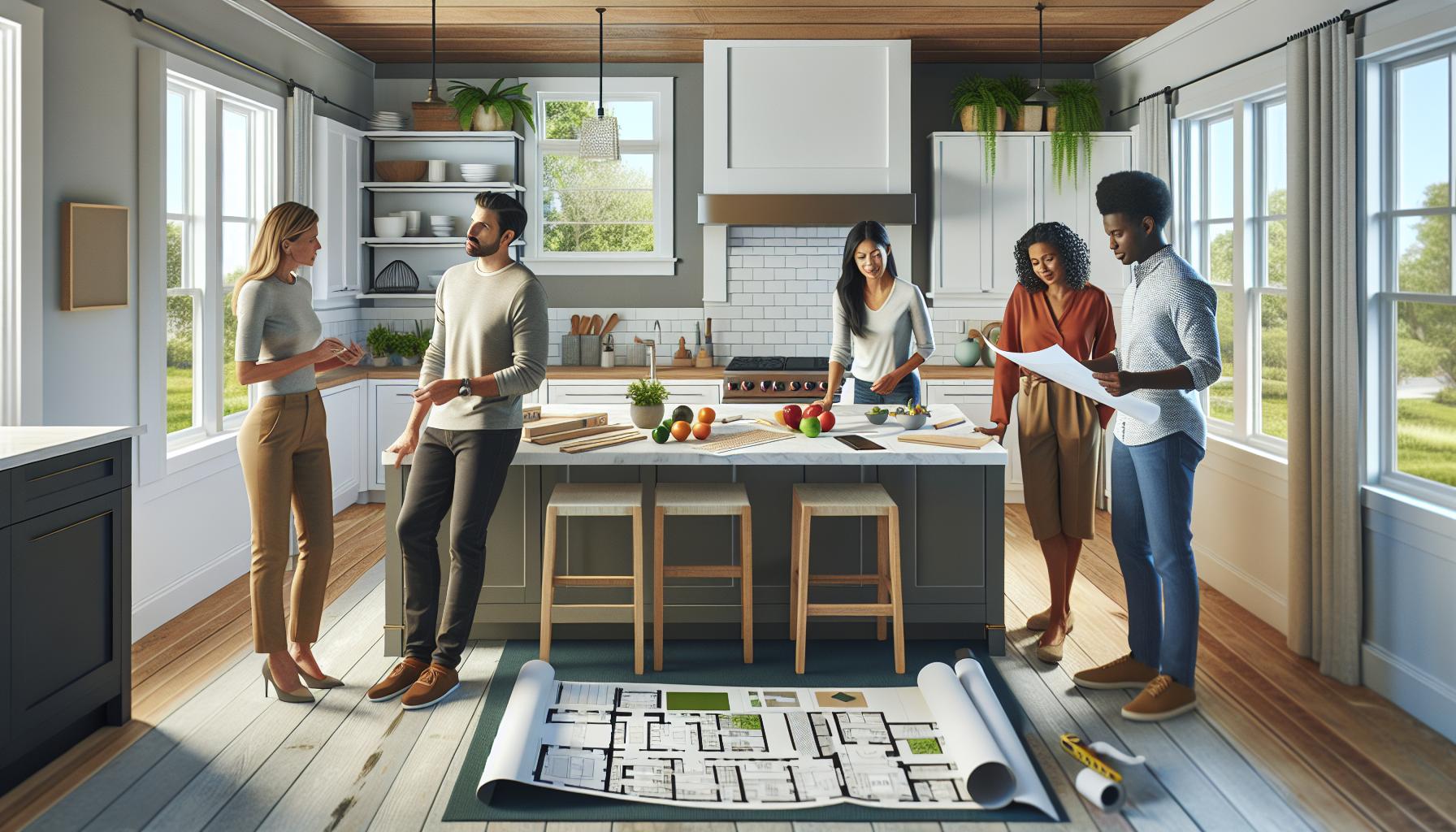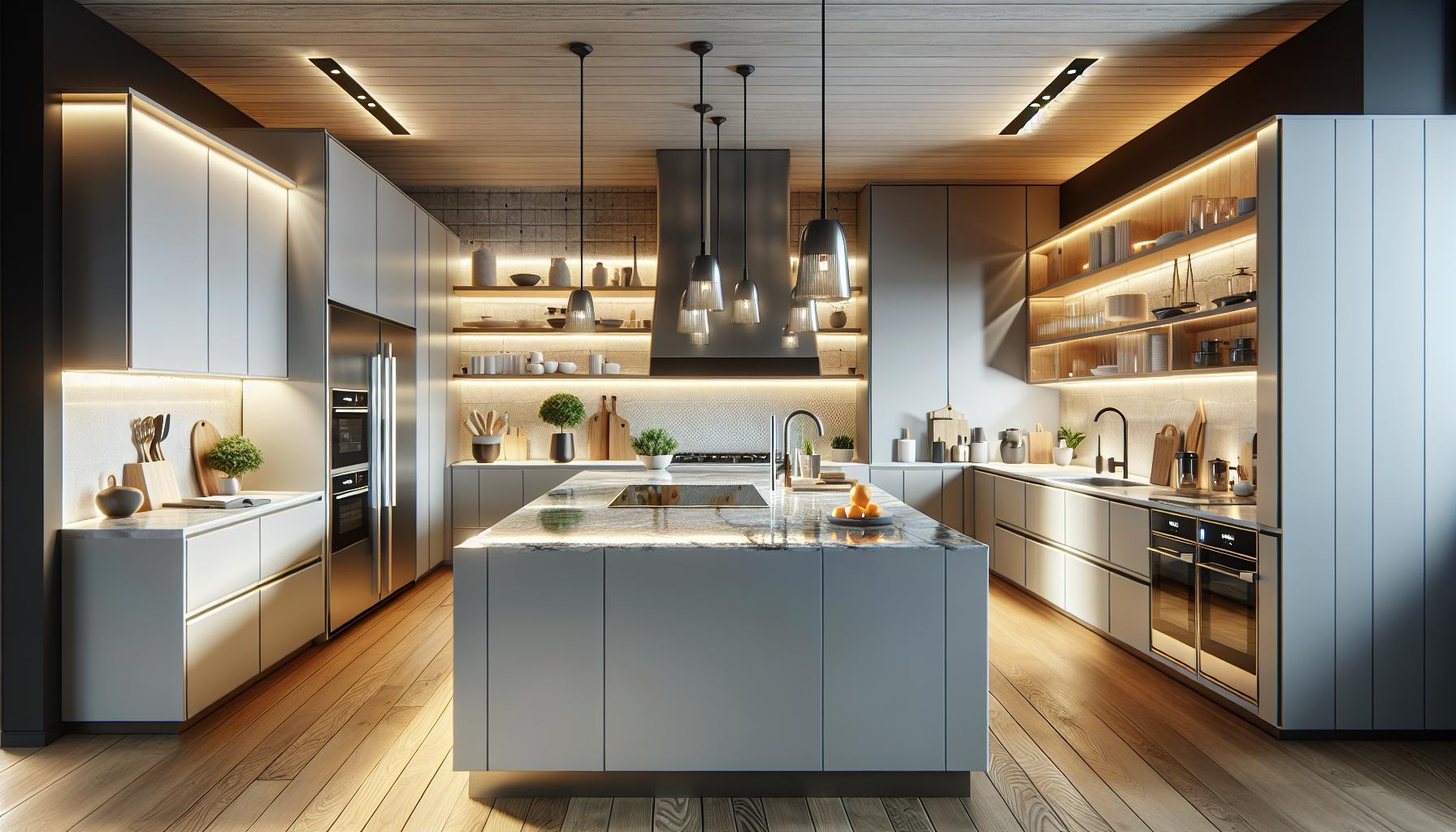Physical Address
304 North Cardinal St.
Dorchester Center, MA 02124
Physical Address
304 North Cardinal St.
Dorchester Center, MA 02124

Modern home renovation isn’t just about a fresh coat of paint or swapping out fixtures—it’s a transformative adventure that turns a house into a personalized sanctuary. Homeowners can envision spaces that not only reflect their unique style but also enhance daily living without turning the process into a chaotic Pinterest board.
In today’s fast-paced world, embracing the latest design trends and smart technologies makes renovations feel less like a chore and more like an exciting upgrade. From open-concept layouts that foster connectivity to eco-friendly materials that benefit both the environment and the wallet, modern renovations offer endless possibilities. Plus, integrating humor and creativity can make the journey enjoyable and stress-free.
Ready to breathe new life into a home? Exploring the essentials of modern home renovation can make the experience both thrilling and rewarding, ensuring a space that’s as functional as it is fabulous.
Begin by setting a clear budget to guide all renovation decisions. Allocate specific amounts for key areas such as kitchen upgrades, bathroom fixtures, and smart home installations. For example, designate $15,000 for kitchen remodeling and $10,000 for bathroom enhancements.
Next, define the renovation goals and prioritize essential improvements. Identify which areas require immediate attention and which can wait. Focus on creating open-concept layouts and integrating eco-friendly materials to enhance both functionality and sustainability.
Research current design trends and select materials that align with the modern aesthetic. Choose durable finishes like quartz countertops and energy-efficient appliances to ensure longevity and reduce maintenance costs. Incorporate smart technologies such as automated lighting systems and thermostats to increase home efficiency.
Consult with professionals to gain expert insights and refine the renovation plan. Engage architects for layout designs, contractors for accurate estimates, and interior designers for cohesive styling. Their expertise ensures that the project stays on track and meets quality standards.
Develop a realistic timeline to manage the renovation process effectively. Break down the project into phases, such as demolition, construction, and finishing touches. For instance, allocate two months for structural changes and one month for interior decorating to maintain steady progress.
Obtain necessary permits and approvals to comply with local regulations. Ensure all documentation is accurate to avoid legal complications and project delays. This step is crucial for structural modifications and installing new electrical or plumbing systems.
Lastly, prepare for unexpected challenges by setting aside contingency funds. Allocate approximately 10-15% of the total budget for unforeseen expenses. This approach minimizes financial strain and keeps the renovation on schedule despite potential setbacks.
| Renovation Aspect | Budget Allocation | Timeline |
|---|---|---|
| Kitchen Remodeling | $15,000 | 2 months |
| Bathroom Enhancements | $10,000 | 1 month |
| Smart Home Installations | $5,000 | 1 month |
| Contingency Fund (10%) | $3,000 | N/A |
Planning a modern home renovation involves detailed budgeting, prioritizing goals, researching trends, consulting professionals, creating timelines, obtaining permits, and preparing for unexpected costs. This structured approach ensures a successful and stress-free renovation experience.

Focusing on essential spaces ensures a balanced and functional home renovation. Prioritizing these areas can significantly enhance both aesthetics and livability.
Updating the kitchen transforms it into a modern, efficient workspace. Installing energy-efficient appliances can reduce utility costs by up to 20 percent. Replacing countertops with durable materials like quartz or granite enhances both durability and style. Incorporating smart storage solutions maximizes space, making the area more functional. Upgrading lighting fixtures improves visibility and ambiance, creating a welcoming environment. Adding an island provides additional workspace and seating options. Choosing eco-friendly cabinets promotes sustainability and long-term savings. These improvements collectively increase the home’s value and appeal.
Modernizing the bathroom enhances comfort and functionality. Installing low-flow toilets and faucets can reduce water usage by approximately 30 percent. Upgrading to LED lighting improves energy efficiency and lighting quality. Replacing old fixtures with contemporary designs updates the space’s appearance. Adding heated floors increases comfort during colder months. Incorporating smart mirrors with defogging capabilities streamlines morning routines. Using moisture-resistant materials prevents mold and extends the lifespan of surfaces. These upgrades create a luxurious and efficient bathroom environment.
Selecting modern materials is crucial for successful home renovations. Sustainable Wood offers durability and eco-friendliness, with options like bamboo and reclaimed lumber enhancing aesthetic appeal. Recycled Metal provides strength and versatility, utilizing steel and aluminum sourced from recycled products. Energy-Efficient Glass improves insulation and natural lighting, featuring double-glazed and low-emissivity (Low-E) options. Concrete delivers both functionality and style, available in polished, stained, or textured finishes. Composite Materials combine durability with low maintenance, including engineered stone countertops and composite decking.
| Material Type | Benefits | Common Uses |
|---|---|---|
| Sustainable Wood | Eco-friendly, durable | Flooring, cabinetry |
| Recycled Metal | Strong, versatile | Structural elements, fixtures |
| Energy-Efficient Glass | Insulates, enhances natural light | Windows, doors |
| Concrete | Functional, stylish | Countertops, flooring, walls |
| Composite Materials | Durable, low maintenance | Countertops, decking, siding |
Sustainable Wood reduces environmental impact while adding warmth to interiors. Recycled Metal not only conserves resources but also offers a modern industrial look. Energy-Efficient Glass minimizes energy loss, supporting climate control within the home. Concrete serves as a robust foundation and a sleek design element. Composite Materials provide long-lasting surfaces that withstand wear and tear, ideal for high-traffic areas.
Prioritizing these materials ensures renovations align with contemporary standards and environmental considerations. Homeowners benefit from materials that enhance both functionality and style, contributing to a modern, sustainable living space.
Integrating smart home technology enhances modern renovations by boosting efficiency and convenience. Smart thermostats, such as Nest and Ecobee, optimize heating and cooling, reducing energy consumption by up to 15%. Automated lighting systems, including Philips Hue and LIFX, allow remote control and scheduling, contributing to energy savings and customized ambiance. Security systems like Ring and SimpliSafe provide real-time monitoring and alerts, increasing home safety.
Smart appliances improve functionality in key areas. Refrigerators from Samsung and LG offer features like remote temperature control and inventory tracking. Smart ovens, such as June and Thermomix, enable precise cooking settings and remote operation. These appliances streamline daily tasks and enhance the home’s technological appeal.
Voice assistants, including Amazon Alexa and Google Assistant, centralize control of various devices. Homeowners manage lighting, thermostats, and security systems through simple voice commands, enhancing overall convenience. Additionally, smart home hubs integrate multiple devices, ensuring seamless communication and operation.
Implementing sustainable renovation practices minimizes environmental impact and enhances home efficiency. Energy efficiency upgrades reduce utility costs and lower carbon footprints. Installing insulation materials like cellulose or recycled denim maintains indoor temperatures, decreasing heating and cooling demands. Solar panels generate renewable energy, providing a sustainable power source and potential savings on electricity bills.
Utilizing water conservation systems such as low-flow fixtures and rainwater harvesting reduces water usage. Greywater systems recycle water from sinks and showers for irrigation and flushing toilets, promoting responsible water management. Smart thermostats optimize heating and cooling schedules, ensuring energy is used only when necessary.
Selecting eco-friendly building materials supports sustainability goals. Products like Bamboo flooring offer durability and rapid renewability, while recycled glass countertops provide aesthetic appeal with minimal environmental impact. Choosing low-VOC paints improves indoor air quality by reducing harmful emissions.
Waste reduction strategies during renovations contribute to environmental preservation. Recycling construction debris and donating usable materials prevent landfill accumulation and support community projects. Modular and prefabricated components minimize waste by allowing precise manufacturing and reducing on-site material excess.
Incorporating green certifications ensures adherence to sustainable standards. Obtaining certifications like LEED (Leadership in Energy and Environmental Design) or Energy Star validates the effectiveness of renovation practices and can increase property value. These certifications demonstrate a commitment to environmental responsibility and attract eco-conscious buyers.
Employing these sustainable renovation practices creates a healthier living environment while promoting conservation and efficiency. Homeowners prioritize sustainability by integrating energy-efficient systems, water conservation measures, eco-friendly materials, and waste reduction techniques, resulting in a modern, responsible, and resilient home.
Selecting the right professionals ensures a successful home renovation. Start by identifying licensed contractors with proven experience in modern renovations. Verify their credentials and check references to confirm their reliability and quality of work. Prioritize those who specialize in areas like kitchen and bathroom remodels, aligning with your renovation goals.
Interview multiple candidates to assess their understanding of your project and their ability to communicate effectively. Evaluate their portfolios to ensure their design style matches your vision. Request detailed quotes that break down costs, helping you compare budgets accurately. Choose professionals who demonstrate transparency and offer comprehensive plans, reducing the risk of unexpected expenses.
Consider collaborating with architects and interior designers who can provide innovative solutions and optimize space functionality. Their expertise in incorporating smart technologies and sustainable materials can enhance your home’s efficiency and aesthetic appeal. Ensure they are familiar with local building codes and can obtain necessary permits, streamlining the renovation process.
Establish clear contracts outlining project timelines, payment schedules, and scope of work. This clarity prevents misunderstandings and keeps the project on track. Professionals who prioritize punctuality and adherence to deadlines contribute to a stress-free renovation experience. Their commitment to quality and attention to detail ultimately results in a functional and stylish modern home.
| Professional Type | Key Responsibilities |
|---|---|
| Licensed Contractors | Oversee construction, ensure compliance with codes |
| Architects | Design layouts, optimize space, integrate smart technologies |
| Interior Designers | Select materials, furnishings, and color schemes |
| Specialized Remodelers | Focus on specific areas like kitchens and bathrooms |
Choosing the right team empowers homeowners to achieve their renovation objectives efficiently and effectively, transforming their spaces into modern, personalized havens.
Modern home renovation seamlessly blends style with functionality, creating spaces that truly reflect homeowners’ personalities. By integrating the latest design trends and smart technologies, living areas become more efficient and enjoyable. Prioritizing sustainable materials ensures that renovations are both eco-friendly and durable, contributing to a healthier home environment.
Collaborating with skilled professionals and meticulous planning pave the way for a smooth renovation process. Embracing these approaches allows homeowners to achieve beautiful and practical results without unnecessary stress. As the demand for personalized and innovative living spaces grows, modern home renovations continue to redefine what it means to create a comfortable and stylish home.